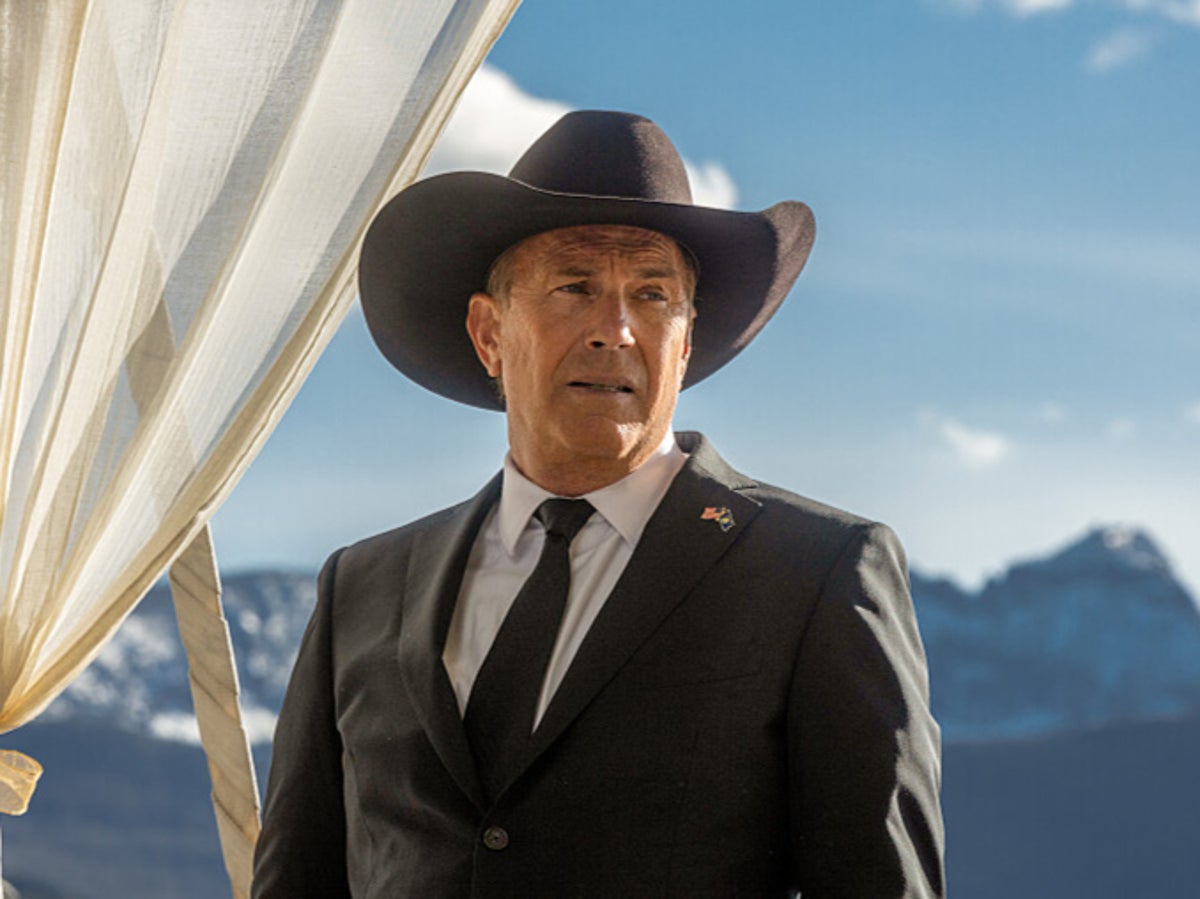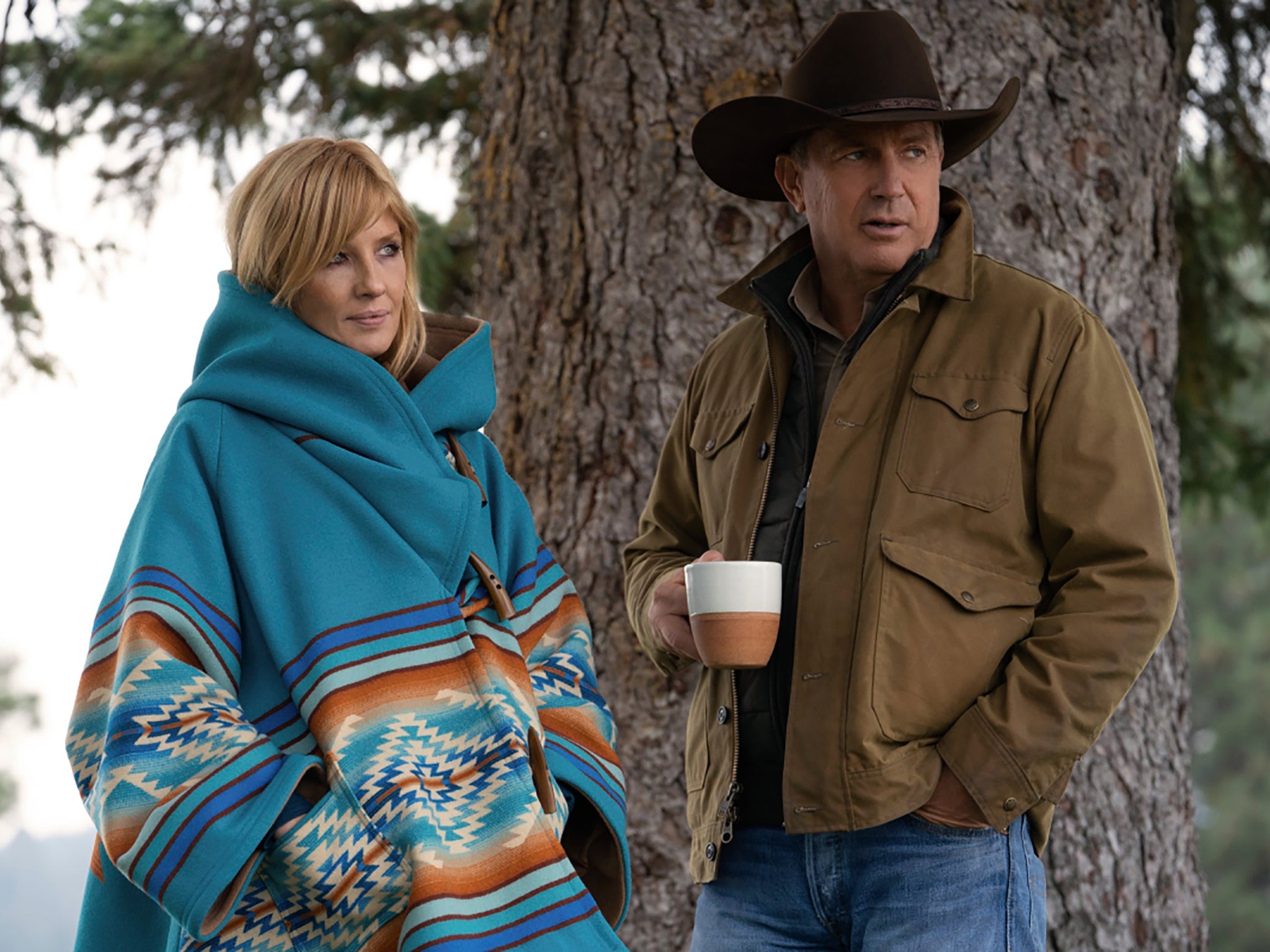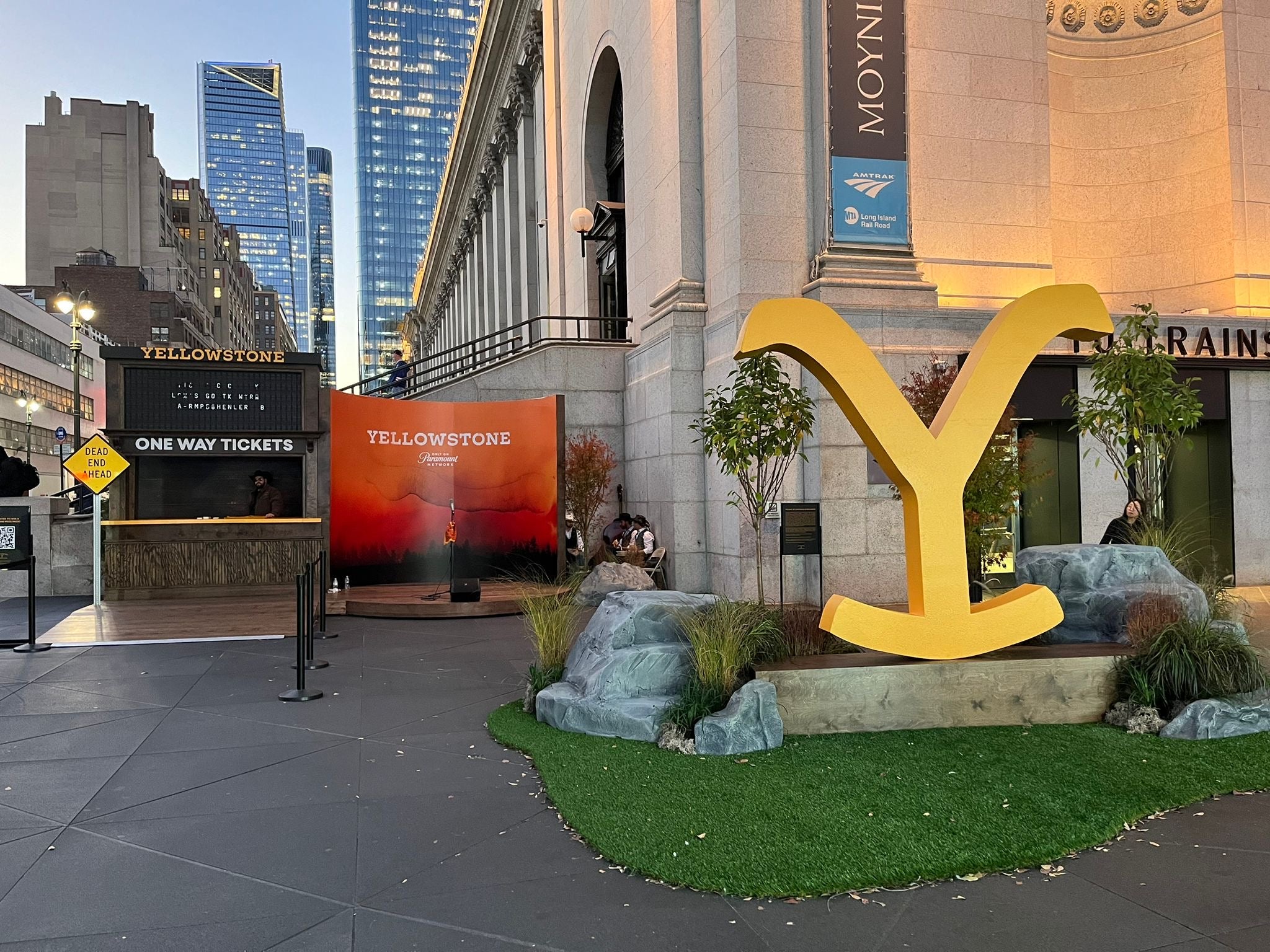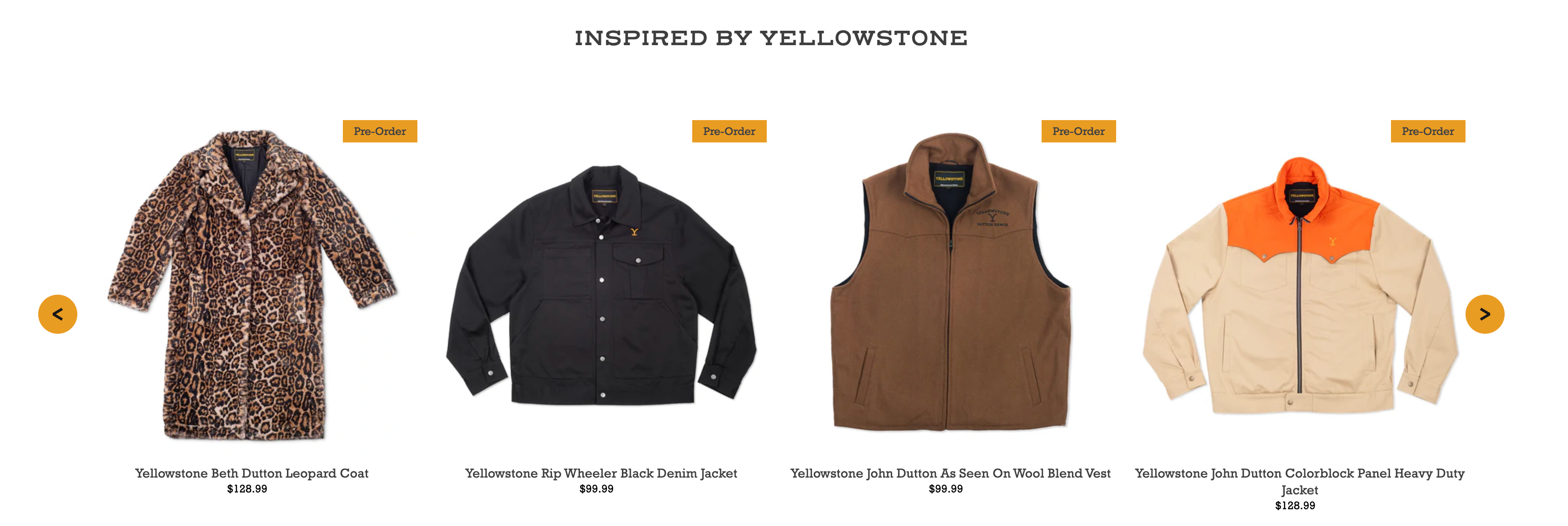
If you’re not already familiar with the logo, you’ll soon start to see it everywhere: A “Y” made of two cattle brands rocking, the signature of the protagonist Dutton family ranch on Paramount hit series Yellowstone.
You’ll spot that distinctive “Y” on hoodies and car decals, tote bags and phone cases. At the annual motorcycle rally in Sturgis last year, shops and stands lining biker-filled streets were selling Yellowstone swag alongside shelves laden with pro-Trump merchandise.
Drop into any rural Walmart or Colorado rest stop, and Dutton sweatshirts are likely on sale in the aisles.
You can even pick up an official Yellowstone branded version of Beth Dutton’s leopard coat from her wedding outfit.
Since the Western drama’s 2018 premiere, it has spawned spinoffs and ubiquitous show-themed items for purchase; franchise tentacles have appeared across countless aspects of pop culture and consumerism.
Just this week, before part 2 of Yellowstone’s season 5 is released on Sunday, Drew Barrymore was gushing about a themed Monopoly set and Nascar’s Jeffrey Earnhardt posted on social media about Dutton excitement.

An advertising popup in New York City this week offered passers-by photo ops and bandanas; at a MAGA watch party on election night in northern Colorado, at least three people were sporting Dutton-branded items – including The Independent’s reporter, a Beth Dutton fan who made an impulse buy three years ago at a mountain town artisanal store selling a red flannel shirt with the character’s moody photo imprinted on the back.
“That sort of thing doesn’t normally happen with most brands. It’s almost become sort of a cultural phenomenon, in a way that people want to do everything they can to expose themselves to the brand and showcase their love of the narrative and the story of the characters,” digital marketing analyst Jonas Sickler, who’s delved into the relevant search data, tells The Independent.
At one point, “consumer interest for Yellowstone was outstripping the Nielsen ratings, showing that the show itself was more than just a piece of entertainment,” he says. “It had become something of a lifestyle to live – I mean, there was home decor, and how to get the outfits and how to dress like the characters … there’s card decks.”
Perhaps indicative of Yellowstone’s commercial saturation, its creator, Taylor Sheridan, sued one of its actors, Cole Hauser, over alleged copyright infringement – an argument sparked by the stars’ competing coffee companies.
Trends have shown a significant dip in search interest since the show went on hiatus after the beginning of Season 5 – a prolonged filming pause that not only left fans hanging but also saw the exit of series anchor Kevin Costner. It remains to be seen whether the diehard fanbase, expanded from older viewers still enjoying cable when the show debuted to more diverse fans devouring the series through streaming services, are loyal enough to flock back to their screens.
Regardless, however, the cultural impact of the series is “just undeniable,” says University of Montana professor Katie Kane, who’s working on a paper about Yellowstone which she first discussed last year at a film and literary conference in Missoula.
“Yellowstone is everywhere now,” says Kane, a North Dakota native who’s lived since 1999 in Montana, where residents hold conflicted feelings about the Paramount series, to put it mildly.
“It is everywhere in the United States, because it sort of picks up on that old, almost primary, set of texts that accompany the ‘settlement of the West’ – so I mean the pulp fiction of the 19th century … it’s just a long-standing kind of mythic trope.”
That romanticization of the West taps into another facet of many Americans’ psyche – the same motivator behind the reality that “over 40,000 more people moved to the state than left between 2020 to 2022, ranking Montana second in the nation for largest percentage of net in migration,” she says, quoting the 2023 Montana Labor Day report.
“They’re coming here because, whether it’s true or not, there’s a very strong felt sense that life is becoming precarious – whether that’s inflation or climate change or changing demographics, whatever. And when change starts to accelerate or it seems beyond their control – and I know I’m English lit professor saying this – they turn toward the safety of familiar narratives.
“And Montana seems like a place where you could go to escape whatever is going on in the rest of America, especially in the big, urban centers … pollution, overcrowding, inflation.

“What Americans want,” she says, “is the simpler … not that that ever existed, right? But the simpler time, or the time that was less complicated for certain kinds of people to live in – never uncomplicated for indigenous people, but seemingly uncomplicated for certain kinds of folks … an imaginative place.”
The Paramount and franchise team have shrewdly keyed into that nostalgia, going hell-for-leather on brand partnerships and lifestyle opportunities across the board.
In ViacomCBS’s submission for the “Instagram Presence” category of the 13th Annual Shorty Awards, the team wrote about its strategy to “help fans evangelize for the show and feel like they’re a part of the larger Yellowstone community.
“We understand the love and devotion surrounding Yellowstone, and we feed that passion with quick wit and celebratory zeal.”
The devotion was evident when looking at internet search patterns, Sickler wrote last year for predictive online brand management company Terakeet, comparing search interest to 2022 television ratings figures.
“Yellowstone ranked third on the 2022 Nielsen top 10 ratings list with an average audience size of 11.31million,” he wrote. “But if we compare these shows using consumer search data instead, Yellowstone has 6x the audience search interest compared to the average of the other 9 shows.”
Riding the wave of popularity at Yellowstone’s peak, teams behind the series broadened its reach strategically and exponentially – publicly gloating about the success story.
“There are no other modern adult franchises that can say they’ve inspired a lifestyle brand,” Lourdes Arocho, Paramount’s senior vice president of consumer products and experiences, said in a sponsored content piece published earlier this year.
Noting that the show had “reinvigorated interest in everything from denim to cowboy hats,” Arocho added that it had also “done more than inspire a fashion movement. We’re in everything from publishing to fragrances to furniture.”
Triumphs then listed included the publication by Paramount partner Insight Editions of Yellowstone: The Official Dutton Ranch Family Cookbook and a collaborative line of foods with partner FoodStory Brands, including coffee, meats, marinades and seasonings.
This week, clothing brand Free People announced a partnership with Paramount that includes an eight-piece limited-edition collection available at the brand’s site and select stores across the country – offering items ranging from a $58 graphic T-shirt to a $498 suede jacket, all of them stamped with the signature “Y” brand.

Back at the University of Montana, Kane laughs that her in-progress paper is “an anti-Yellowstone rant” while conceding that the reach of the show remains “just crazy.”
“There’s not just the usual sort of tie-ins or commercial products or T-shirts,” she tells The Independent. “I mean, this Monopoly game is really, really sophisticated – not just like a board with markers for Yellowstone but … the properties are all Dutton properties, the cards are key to sayings like ‘Be a man’ or what have you.”
Residing and teaching in Montana while much of America seeks to emulate its perceived lifestyle based upon a TV show, she says, is “like living in the shadow of a myth.”
“They want to experience a kind of Americanness that really never was.”







